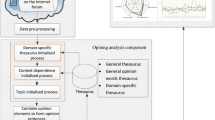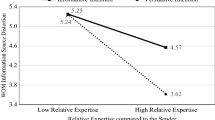Abstract
Word-of-Mouth (WOM) may impact the perception and experience of website usability and visual appeal. This study aimed to highlight the effects of WOM, implemented textually and verbally, on subjective and objective usability and visual appeal in a web environment. This research was spread over three studies and was undertaken using an unfamiliar city council website to exclude the influence of past experiences and to allow for greater control of WOM implementation. The statistical results showed that both visual appeal and objective and subjective usability were influenced via text that established expectations around these and that the results were only more compelling when verbal WOM was added. The result implications show that when the message is simple, such as it usually is in communication on social media and advertising, then it does impact people’s perceptions of website visual appeal and usability, which may impact future intentions.















Similar content being viewed by others
References
Heidmann F (2009) Human–computer cooperation. In: Bullinger HJ (ed) Technology guide. Springer, Heidelberg
Litvin S, Goldsmith R, Pan B (2008) Electronic word-of-mouth in hospitality and tourism management. Tour Manag 29(3):458–468
Forrester Research: The State of Retailing Online (2006) The 9th annual shop.org study. www.clickz.com/3611181
Burtuskova A, Krejcar O Evaluation framework for user preference research implemented as web application. In: Badica C, Nguyen NT, Brezovan M (eds) ICCCI, 201, LNCS, vol 8083, Heidelberg, pp 537–548
ISO 9241/11 (1996) International organization for standardization. Retrieved June 2012
Feagin SF (1995) Beauty. In: Audi R (ed) The Cambridge dictionary of philosophy Cambridge. Cambridge University Press, Cambridge, p 66
Blijlevens J (2011) Typically the best? Perceived typicality and aesthetic appraisal of product appearances. PhD thesis, Delft University of Technology, The Netherlands
Gefen D, Karahanna E, Straub D (2003) Trust and TAM in online shopping: an integreated model. MIS Quart 27(1):51–90
Stojmenović M, Pilgrim C, Lindgaard G (2014) Perceived and objective usability and visual appeal in a website domain with a less developed mental model. In: The 26th ACM Australian Computer–Human Interaction Conference OZCHI’14, December 2–5, 2014, Sydney, NSW, Australia, pp 316–323
Stojmenović M, Grundy J, Farrell V, Biddle R, Hoon L (2016) Does textual word-of-mouth affect look and feel? In: The 28th ACM Australian Computer–Human Interaction Conference OZCHI’16, November 29–December 2, Launceston, Tasmania, Australia, pp 257–265
Festinger L (1957) A theory of cognitive dissonance. Stanford University Press, Stanford
Harmon-Jones E, Amodio DM, Harmon-Jones C (2009) Action-based model of dissonance: a review, integration, and expansion of conceptions of cognitive conflict. In: Zanna MP (ed) Advances in experimental social psychology, vol 41. Academic Press, Burlington, pp 119–166
Tractinsky N, Katz AS, Ikar D (2000) What is beautiful is usable. Interact Comput 13(2):127–145
Dion KK, Berscheid E, Walster E (1972) What is beautiful is good. J Personal Social Psychol 24:285–290
Thorndike EL (1920) A constant error in psychological ratings. J Appl Psychol 4(1):25–29
Hall RH, Hanna P (2004) The impact of web page text-background colour combinations on readability, retention, aesthetics and behavioural intention. Behav Inf Technol 23(3):183–195
Hartmann J, Sutcliffe A, De Angeli A (2007) Investigating attractiveness in web user interfaces. In: Proceedings of the SIGCHI Conference on Human Factors in Computing Systems, p 396
Tractinsky N (1997) Aesthetics and apparent usability: empirically assessing cultural and methodological issues. In: Proceedings of ACM SIGCHI, New York, ACM, pp 115–122
Norman D (2004) Emotional design: Why we love (or hate) everyday things. Basic Books, New York
Katz A (2010) Aesthetics, usefulness and performance in user-search-engine. Int J Appl Quant Methods 5(3):424–445
Tuch AN, Roth SP, Hornbæk K, Opwis K, Bargas-Avila JA (2012) Is beautiful really usable? Toward understanding the relation between usability, aesthetics, and affect in HCI. Comput Hum Behav 28(5):1596–1607
De Angeli A, Sutcliffe A, Hartmann J (2006) Interaction, usability and aesthetics: What influences users’ preferences?. University Park, College Town, pp 271–280
Lee S, Koubek RJ (2010) Understanding user preferences based on usability and aesthetics before and after actual use. Interact Comput 22(6):530–543
Sangwon L, Koubek RJ (2010) Understanding user preferences based on usability and aesthetics before and after actual use. Interact Comput 22(6):530–543
Taebi O, Aldabbas H, Clarskon M (2013) Users’ perception towards usability and aesthetics design of travel websites. In: Proceedings of The International Conference on E-Commerce and Information Technology, vol 117, EcomIT & GBM, Sri Lanka
Quinn JM, Tran TQ (2010) Attractive phones don’t have to work better: independent effects of attractiveness, effectiveness, and efficiency on perceived usability. In: CHI’10: Proceedings of the 28th International Conference on Human Factors in Computing Systems, New York, pp 353–362
McLellan S, Muddimer A, Peres SC (2012) The effect of experience on system usability scale ratings. J Usability Stud 7(2):56–67
Ip C, Law R, Lee H (2011) A review of website evaluation studies in the tourism and hospitality fields from 1996 to 2009. Int J Tour Res 13(3):234–265
Sokkar A, Law E (2013) Validating an episodic UX model on online shopping decision making: a survey study with B2C e-commerce. IN: Proceedings of the 5th ACM SIGCHI Symposium on Engineering Interactive Computing Systems, pp 297–306
Granovetter MS (1973) The strength of weak ties. Am J Sociol 78(6):1360–1380
Herr PM, Kardes FR, Kim J (1991) Effects of word-of-mouth and product-attribute information on persuasion: an accessibility-diagnosticity perspective. J Consum Res 17(4):454–462
Smith D, Menon S, Sivakumar K (2005) Online peer and editorial recommendations, trust, and choice in virtual markets. J Interact Market 19(3):15–37
Pavlou PA, Dimoka A (2006) The nature and role of feedback text comments in online marketplaces: implications for trust building, price premiums, and seller differentiation. Inf Syst Res 17(4):392–414
Davis FD (1989) Perceived usefulness, perceived ease of use, and user acceptance of information technology. MIS Q 13(3):319–340
Ba S, Pavlou PA (2002) Evidence of the effect of trust building technology in electronic markets: price premiums and buyer behavior. MIS Q 26(3):243–268
Chevalier J (2006) The effect of word of mouth on sales: online book reviews. J Market Res 43(3):9
Vermeulen IE, Seegers D (2009) Tried and tested: the impact of online hotel reviews on consumer consideration. Tour Manag 30(1):123–127
Voss B (1984) Slips of the ear: Investigations into the speech perception behaviour of German speakers of English. G. Narr, Tübingen
Chandy R, Gu H (2012) Identifying spam in the iOS app store. Paper Presented, pp 56–59. https://doi.org/10.1145/2184305.2184317
Ellison G, Fudenberg D (1995) Word-of-mouth communication and social learning. Q J Econ 110(1):93–125. https://doi.org/10.2307/2118512
Asch SE (1951) Effects of group pressure on the modification and distortion of judgments. In: Guetzkow H (ed) Groups, leadership and men. Carnegie Press, Pittsburgh, pp 177–190
Asch SE (1955) Opinions and social pressure. Sci Am 193:31–35
Asch SE (1956) Studies of independence and conformity. A minority of one against a unanimous majority. Psychol Monogr 70(9):1–70
Svahnberg M, Aurun A, Wohlin C (2008) Using students as subjects—an empirical evaluation. In: Proceedings of the Second ACM-IEEE International Symposium on Empirical Software Engineering and Measurement ESEM ‘08. 288-290
Druckman JN, Kam CD (2009) Students as experimental participants: a defense of the “narrow data base”*. SSRN: http://ssrn.com/abstract=1498843
Brooke J (1986) System usability scale (SUS). © Digital Equipment Corporation, UK
Moshagen M, Thielsch M (2012) A short version of the visual aesthetics of websites inventory. Behav Inf Technol 32(12):1305–1311
Kruskal W (1952) Use of ranks in one-criterion variance analysis. J Am Stat Assoc 47(260):583–621
Kampstra P (2008) Beanplot: a boxplot alternative for visual comparison of distributions. J Stat Softw 28(1):1–9
Razali NM, Wah YB (2011) Power comparisons of Shapiro-Wilk, Kolmogorov-Smirnov, Lilliefors and Anderson-Darling tests. J Stat Model Anal 2(1):21–33
Shapiro SS, Wilk MB (1965) An analysis of variance test for normality (complete samples). Biometrika 52(3/4):591–611
Cramer D, Howitt D (2004) The SAGE dictionary of statistics. SAGE, London
Doane DP, Seward LE (2011) Measuring skewness. J Stat Educ 19(2):1–18
Martin WE, Bridgmon K (2012) Quantitative and statistical research methods: from hypothesis to results. Wiley, Somerset
Nordstokke DW, Zumbo BD, Cairns SL, Saklofske DH (2011) The operating characteristics of the nonparametric Levene test for equal variances with assessment and evaluation data. Pract Assess Res Eval 1(5):1–8
Rettig M (1991) Nobody reads documentation. Commun ACM 34(7):19–24
Felder RM (1993) Reaching the second tier: learning and teaching styles in college science education. J Coll Sci Teach 23:286–290
Acknowledgements
Thanks to Milos Stojmenovic for creating the website data sample and thanks to Gitte Lindgaard for advice on previous related work.
Author information
Authors and Affiliations
Corresponding author
Rights and permissions
About this article
Cite this article
Stojmenovic, M., Biddle, R., Grundy, J. et al. The influence of textual and verbal word-of-mouth on website usability and visual appeal. J Supercomput 75, 1783–1830 (2019). https://doi.org/10.1007/s11227-018-2313-x
Published:
Issue Date:
DOI: https://doi.org/10.1007/s11227-018-2313-x




